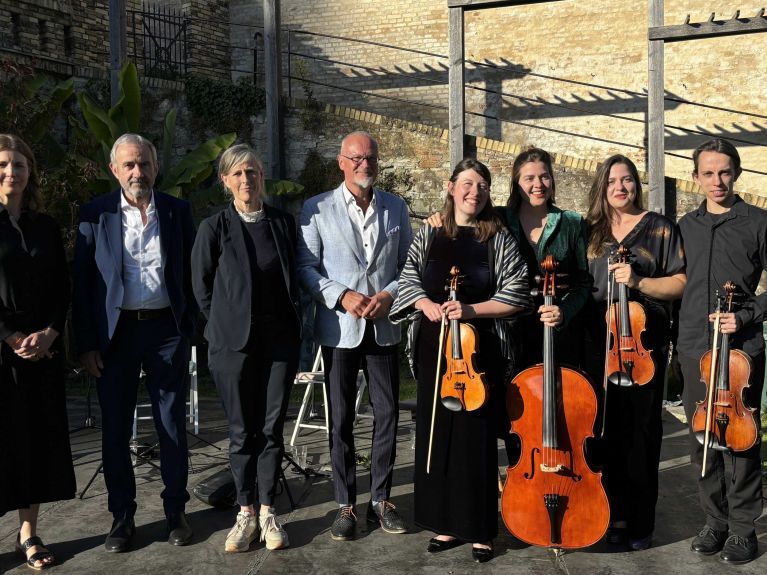Shared history, shared future
Preserving Europe’s cultural heritage and connecting people across national borders: that is the mission of Europa Nostra.

It is 1620 – the Thirty Years’ War is raging in Europe. In the Battle of White Mountain near Prague, the Catholic Habsburgs are victorious over the Protestant Estates of Bohemia. In the following 100 years, many believers fled from these territories, which now belong to the Czech Republic. Among them were numerous members of the Moravian Brethren: this group took refuge in Upper Lusatia, Saxony, in the early 18th century, where they founded the town of Herrnhut.
Herrnhut has been a UNESCO World Heritage Site since 2024 – together with Christiansfeld in Denmark, which was recognised in 2015, and similar settlements in other countries. The Brethren’s congregation is internationally renowned for the so-called Herrnhut Stars, illuminated Advent and Christmas stars with a distinctive geometric design.
Preserving the transnational identity of the religious community and protecting its cultural heritage is a Europe-wide endeavour. This is where Europa Nostra is actively engaged. Since its foundation in 1963, the organisation has been committed to saving endangered monuments, sites and landscapes in Europe. “We are currently building partnerships with settlements of the Moravian Church in Denmark and Poland,” says Uwe Koch, President of Europa Nostra Germany. “We also want to work together with the Czech Republic – which is where the religious refugees originally came from.”
The concept of shared heritage
Europe’s largest civil society network for cultural heritage and based in The Hague, the organisation is supported by public institutions, private companies and individuals in more than 40 countries. In partnership with the European Commission, it recognises outstanding achievements with the “Europa Nostra Awards/European Heritage Awards” in the categories of conservation, research, education and civic engagement, while also bringing together experts and representatives from politics and the public domain at events and conferences.
Based in Potsdam, the German arm of Europa Nostra is particularly committed to the concept of “sharing heritage”, which emphasises dialogue and shared responsibility for cultural heritage. Europa Nostra does not view the idea of shared heritage as nostalgia with a backward focus, however: at its core, the approach aims to make the European dimension of history accessible and draw on it as a foundation for life in the here and now.
Koch explains this taking the example of Lusatia, a region that stretches across parts of Germany, the Czech Republic and Poland and is known for its open-cast coal mining. “The industrial culture of Lusatia is closely intertwined with neighbouring regions in Poland and the Czech Republic, for example. All three areas are able to look back on a history of some 150 years of energy production and coal mining. They now face huge transformation processes.” These shared challenges create a unifying basis for dialogue between those involved – and for a vision of the future based on partnership.

Protection of Ukrainian cultural heritage
The idea of helping to shape the future through a shared European heritage is increasingly relevant in times of war and conflict. With its massive attacks, Russia is destroying Ukraine’s cultural heritage – and destroying Ukrainian identity too, says Koch. This makes it all the more important to offer refugees prospects: an art historian from Kharkiv is currently working for one of Europa Nostra Germany’s important co-operation partners – the Prussian Palaces and Gardens Foundation Berlin-Brandenburg – in the field of painting restoration.
European music trail
Intangible heritage, industrial heritage, monument protection – Europa Nostra is concerned with the entire diversity of cultural heritage. “In spring 2024 we invited the Belgian-Polish Karski Quartet to Potsdam,” says Koch. “The musicians gave an open-air concert on the Winzerberg – which was awarded the European Heritage Prize in 2018 – and then engaged in dialogue with the audience.” Named after Jan Karski, the ensemble was formed based on a shared contemporary approach to chamber music. Karski was a Polish resistance fighter who passed on information about the Holocaust to the Western Allies during the Second World War. Europa Nostra will to continue to promote the combination of music and other elements of cultural heritage in the future. “Ideally we will be able to use the bridges to neighbouring European countries to create a European music trail,” says Koch.

Link between cultural heritage and nature conservation
The organisation also focuses on combining cultural heritage and nature conservation. “Climate change is having a massive impact on cultural heritage,” explains Koch. Historic parks are particularly under threat, he says: heat waves and periods of drought are particularly hard on old trees, while heavy rainfall damages paths and silts up ponds. Palaces, villas and monasteries are often integrated in the design of the gardens, so they are likewise vulnerable to extreme weather conditions.
“We believe that the debate on preserving cultural heritage is inextricably linked to nature conservation: this is why Europa Nostra was represented at the Climate Change Conference in Azerbaijan in November 2024 and also supports the “Global Call to put Cultural Heritage, Arts and the Creative Sector at the Heart of Climate Action”, an initiative that promotes networking between cultural heritage custodians and conservationists while also encouraging interdisciplinary thinking and action. “At the same time we want to convey clearly to the public at large just how much climate change has already become part of our everyday lives,” says Uwe Koch.


